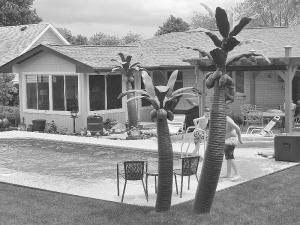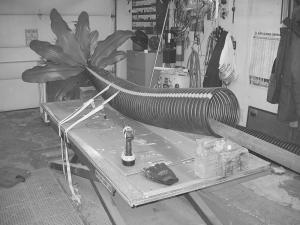2012 - Volume #36, Issue #5, Page #24
[ Sample Stories From This Issue | List of All Stories In This Issue | Print this story
| Read this issue]
He Made Palm Trees For A Backyard Pool
 |
 |
Schiller says his wife said one day that it would be nice if there were palm trees around the 20 by 35-ft. pool. However, he lives in Illinois so real palm trees were out of the question.
“I looked online for artificial palm trees but found they’re very expensive, so I decided to make my own using plastic drain tile, 55-gal. barrels, and real coconuts,” says Schiller.
The homemade trees look realistic, with trunks that bend and taper toward the top. Real coconuts hang from them, and one tree even has a plastic monkey climbing up the trunk.
“I’ve made 3 palm trees, one 7 ft. tall and the others about 12 ft. tall. It took a lot of trial and error to build them, but it was worth the effort,” says Schiller.
He used 55-gal. plastic oil barrels to make the leaves. He makes a pattern and then uses a jigsaw to cut around the barrel, creating strips 25 to 36 in. long and 8 to 10 in. wide depending on the size of the barrel. “I usually get 4 leaves from each barrel,” says Schiller.
The curvature of the barrel is tighter than the curvature of the leaf, so he bends a 3/16-in. thick by 3/4-in. wide metal strap into the curvature he wants and then pop rivets it onto the bottom side of the leaf. “The metal straps give the leaves the right arch and also add strength,” says Schiller.
To make bumps along the leaf’s edges, he puts one end of the metal strap into a vise and then uses a blow torch to heat the plastic so he can bend it. “Once the plastic cools it gets really hard. It’s amazing how much stronger the bends make the leaves,” says Schiller.
He uses 8 to 10-in. dia. drain tile for the tree trunks. To taper the trunk he cuts pie-shaped pieces out of the sides and then uses wire or zip strips to narrow up the diameter.
Lengths of aluminum or steel pipe run through the center of the drain tile to support the trunk. To bend the trunk, he lays the tree on a bench and puts a block of wood under each end. Then he runs ratchet straps around the center of the trunk and pulls the drain tile to one side until it bends. “One of the trees has a really big bend in it. On that tree I actually bent the pipe before I put it into the culvert,” says Schiller.
Once the drain tile is bent he breaks up Styrofoam packaging material into small pieces, then shoves the pieces inside the drain tile until it’s packed full. Then every foot or so, he drills holes into the drain tile’s grooves and squirts Great Stuff aerosol spray foam through them. “The foam expands and packs the drain tile full, which forces the bend to stay in place,” says Schiller.
The next step is to wrap lengths of rope around all the grooves, which smoothes out the trunk and also adds strength.
The tree trunks are anchored in cement about 3 ft. deep in the ground. Both the monkey and the real coconuts are roped to the tree.
All components are brushed with a fiberglass resin and then covered with fiberglass mesh. More fiberglass resin is applied on top of the mesh, and finally everything is primed and painted.
He took photos as he went along and sells plans. “There are a lot of shortcuts on what you can do,” he says.
Contact: FARM SHOW Followup, Doug
Schiller, 345 Biester Dr., Belvidere, Ill. (ph 815 979-4591; flagcaddie@gmail.com).

Click here to download page story appeared in.

Click here to read entire issue
To read the rest of this story, download this issue below or click here to register with your account number.




